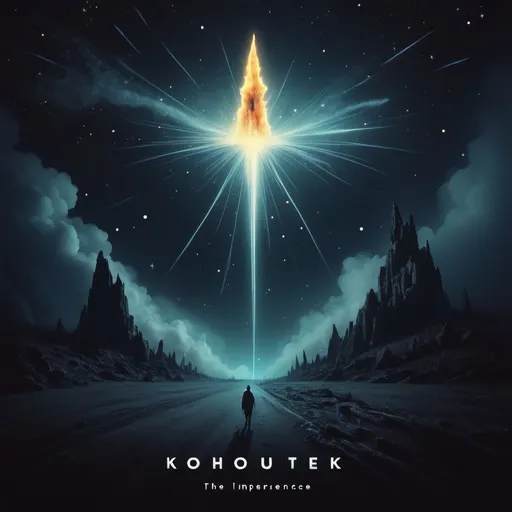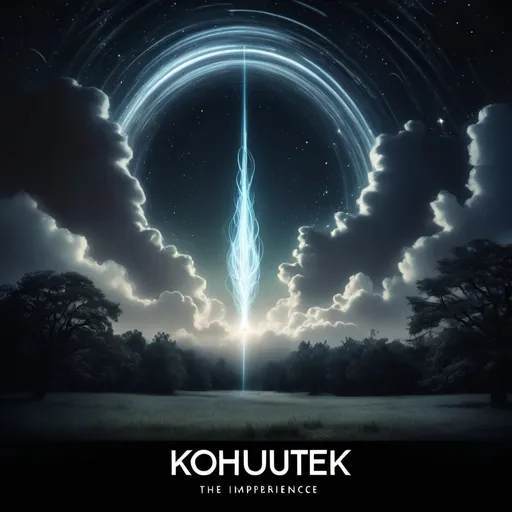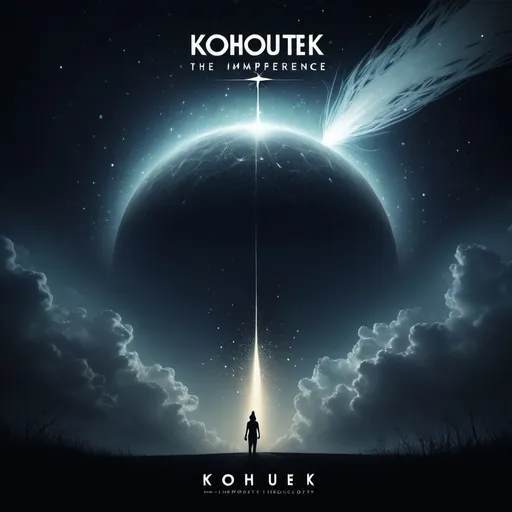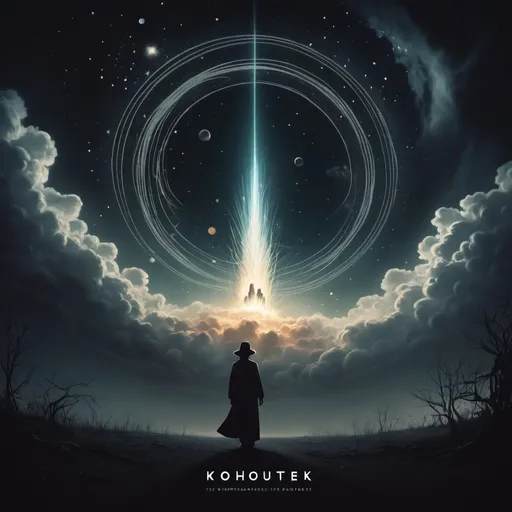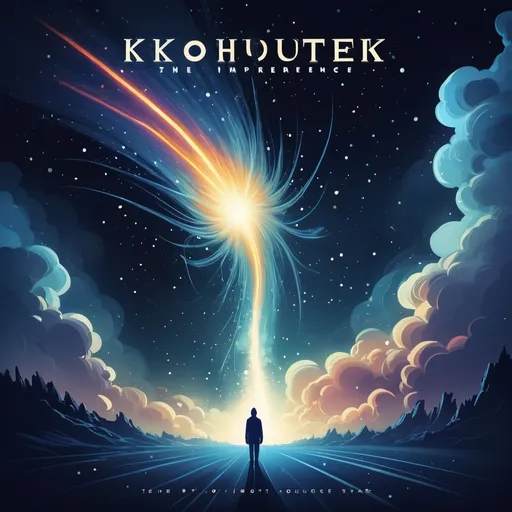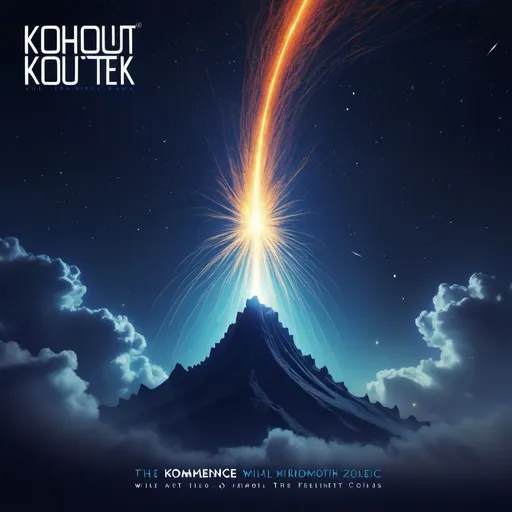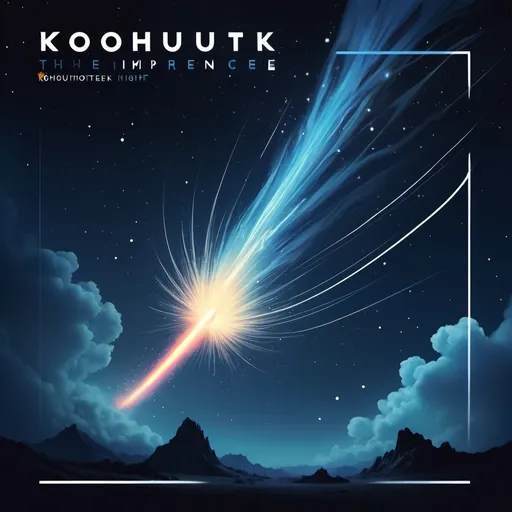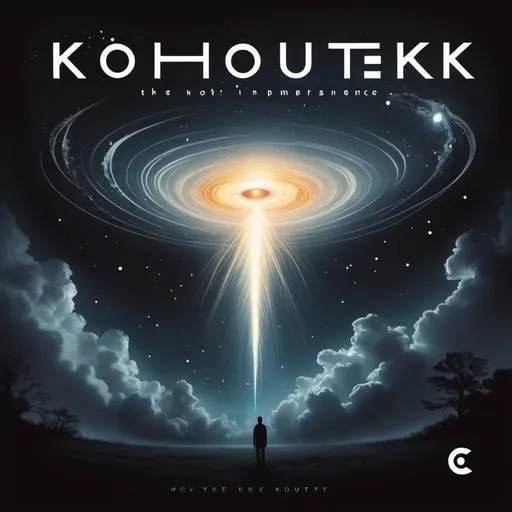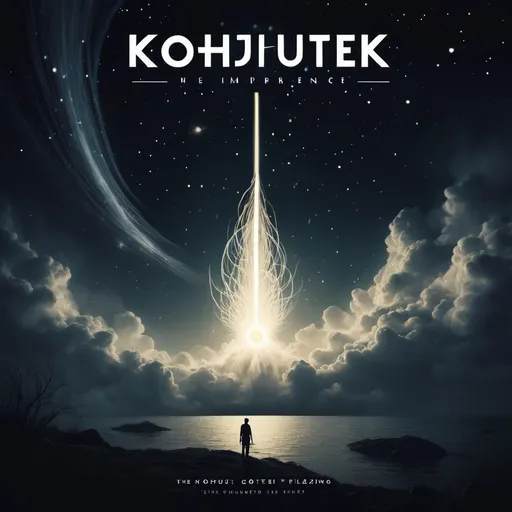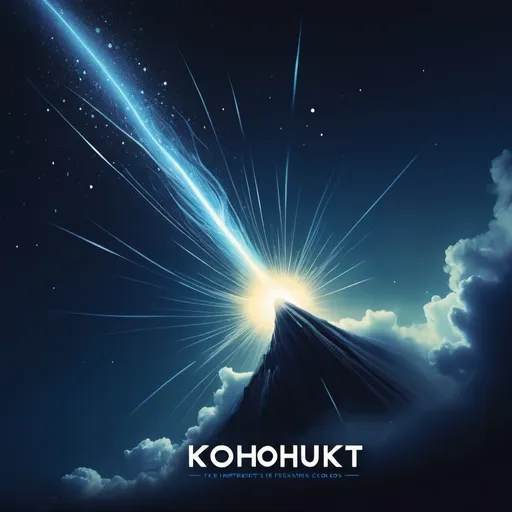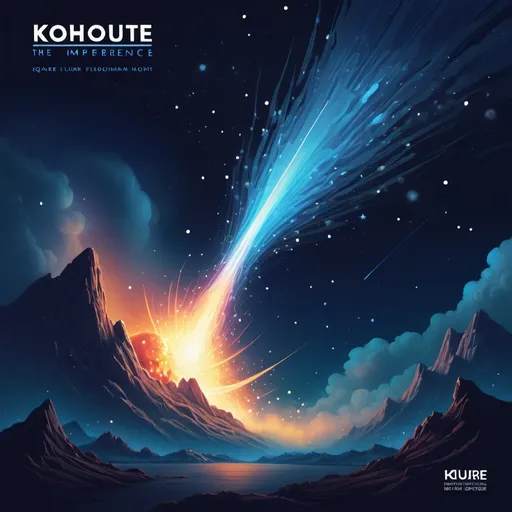Google’s Deep Dive Podcast: TATANKA’s “Kohoutek” (1985)
(AI Gen) TATANKA’s “Kohoutek” (1985) Full Album (1:18:06)
Download (FREE) Audio – Video – Images: kohoutek.zip (3.7 GB)
Video Credit: HD Magical Comets Star-Field - Copyright Free Video
https://youtu.be/LhKujRHUqh0
Motion Backgrounds by: #AAvfx https://www.youtube.com/@AAvfx
Editor’s Note: This project is inspired by a once underground band from Athens, Georgia. It is not meant to sound exactly like them. It is an adaptation of their sound circa 1986, plus a few other periods. It focuses on and expands one of their songs into a concept album, in the framework of a companion narrative. The album’s story, each song a “chapter” developing the overarching theme of impermanence, like the original song. The story progresses from the initial recognition of fleeting moments to a deeper understonding of decay, loss, and the cycle of life. Along the way, as any story should, it goes its own way, symbolic of the theme. The music was difficult enough to emulate, but the vocals were impossible, so I opted for more of a haunting delivery, hopefully straight out of the depths of 1985 Americana. There is some repetition in the lyrics, a tip of the Fedora to the lyricist.
– JJ
01. Fleeting Shadows
Theme: The fleeting nature of memories and their haunting presence.
Chorus:
Fleeting shadows, where the banjos cry,
In the hush of the night, we learn how to die.
Caught in the twang, where the dark secrets slide,
Fleeting shadows whisper, “Come take a ride.”
Verse 1:
Fleeting shadows whisper in the humid night air,
Ghosts of cotton and moonshine tangled in despair.
Echoes of laughter, like moths to the flame,
In the wrinkled sheets of time, who’s left to blame?
Verse 2:
Time spins in circles like a rusted old wheel,
Sweet tea and secrets, nothing left to conceal.
Beneath the old oak, where the lost children play,
Fleeting shadows beckon, as the sun slips away.
Verse 3:
Cracked porcelain memories hang on the wall,
Frayed edges of stories that never recall.
In the parlor of dust, where silence can bite,
Fleeting shadows dance in the pale moonlight.
Verse 4:
Sweet magnolia sighs, suffocating the truth,
Beneath the weight of years, we unearth our youth.
In the corners of dreams, where the wild things roam,
Fleeting shadows whisper, This ain’t your home.
Chorus:
Fleeting shadows, where the banjos cry,
In the hush of the night, we learn how to die.
Caught in the twang, where the dark secrets slide,
Fleeting shadows whisper, “Come take a ride.”
Bridge:
Time is a river, winding with dread,
In the land of the lost, where the living are dead.
Chapter 1: Fleeting Shadows

In the languid embrace of twilight, shadows stretch like languorous ghosts, etching their stories into the fabric of memory. Each flicker of light casts a silent dirge, whispering tales of laughter and sorrow that dissolve into the ether. A child runs through the tall grass, her laughter suspended in the air, while a distant train howls, its wail a reminder of journeys begun and abandoned, evoking a bittersweet nostalgia. Shadows dance across the landscape, a metaphor for the fleeting essence of life, as the girl reaches for something just beyond her grasp.
With the sun dipping beneath the horizon, the girl’s shadows elongate, merging with the fading light, evoking an uncanny sensation of existence slipping away. The world transforms into a kaleidoscope of fragmented moments, shimmering in and out of focus. What is left but echoes of memories that haunt the landscape like wayward specters? These fleeting shadows cling to the corners of her mind, whispering secrets about the past, beckoning her to recall the ephemeral joys that linger like smoke.
In a moment, a gust of wind sweeps through the field, scattering the remnants of yesterday like autumn leaves. The girl is left standing, enveloped in the ghostly silence of twilight, as if the universe holds its breath, waiting for the next fleeting moment to unfurl. The shadows shift and sway, caught in a dance of impermanence, as she realizes that every moment, however brief, is a treasure to be cherished.
02. Erosion’s Breath
Theme: The slow decay of dreams and memories.
Verse 1:
Erosion’s breath hisses like a serpent’s desire,
Sifting through bones of the dreams we conspire.
Dust settles heavy on the cracked church pews,
Where the hollow-eyed saints sing the devil’s blues.
Verse 2:
Time drips like molasses, slow in the heat,
Withered flowers whisper, “You can’t escape defeat.”
In the graveyard of wishes, the past lingers on,
Erosion’s breath chuckles as the light fades at dawn.
Verse 3:
Shadows stretch longer, like fingers of fate,
As ghosts of our futures settle in to wait.
In the silence of twilight, where secrets entwine,
Erosion’s breath lingers, blurring the line.
Verse 4:
Rusted swings creak, like the tales left untold,
In the garden of thorns, where the wild roses fold.
Each moment dissolves in the bitter-sweet rust,
Erosion’s breath whispers, “In decay, we trust.”
Bridge:
Time is a phantom, forever it spins,
In the graveyard of longing, our journey begins.
Chapter 2: Erosion’s Breath

The air hangs heavy with the weight of forgotten dreams, each sigh a testament to aspirations worn down by time. In the distance, a river winds its way through the valley, its waters eroding the banks that once held steadfast. As the protagonist gazes upon this slow decay, she feels the sharp pang of dreams slipping away like sand through fingers. The vibrant hopes of youth begin to blur, merging with the faded palette of her surroundings, a haunting reminder that nothing is permanent.
Underneath the layers of silt and sediment, she can almost hear the echoes of ambitions lost to the currents of life. Each pulse of the water speaks of desires that once danced on the surface, now submerged in a sea of forgetfulness. The protagonist watches as ripples form and dissipate, their impermanence echoing her own internal struggle—an unending battle against the tides of decay. A lingering ache wraps around her heart, mirroring the erosion of her dreams, as she clings to remnants of what could have been.
Yet, within this decay lies a quiet beauty, a poetry woven into the fabric of existence. The protagonist realizes that in acknowledging the erosion of her aspirations, she is simultaneously embracing the richness of her experiences. Like the river carving its path, she learns to flow with the changes, to find solace in the knowledge that impermanence is not merely a loss but a transformative journey.
03. Silted Echoes
Theme: The memories that settle like silt, obscuring the truth.
Verse 1:
Silted echoes linger in the midnight swamp,
Whispers of the willow and the alligator’s chomp.
The past is a riddle wrapped in a skin,
Where dreams go to drown, where the nightmares begin.
Verse 2:
Time’s a slick serpent, slithering by,
In the murky reflections, we learn how to lie.
In the shadows of cypress, where the secrets entwine,
Silted echoes murmur, “You’re running out of time.”
Verse 3:
Faded photographs float on the water’s surface,
Each one a specter, a tale of our purpose.
In the stillness of darkness, we dive deep to see,
Silted echoes giggle, “Will you set yourself free?”
Verse 4:
Moths to the lantern, a dance of the damned,
In the clay of the river, our footprints are jammed.
With each breath we take, another moment drips,
Silted echoes beckon, “Just sink, let it slip.”
Chorus:
Silted echoes, where the silence is thick,
In the shadows we tread, we learn every trick.
Caught in the murmur of the past’s heavy tread,
Silted echoes whisper, “You’re better off dead.”
Bridge:
Time is a puddle, forever it swells,
In the heart of the darkness, we’re under its spells.
Chapter 3: Silted Echoes

In the aftermath of forgotten moments, echoes settle like silt upon the riverbed of her consciousness. Each memory, once vibrant, now lies buried beneath layers of time, obscured by the detritus of everyday life. As she wanders through the remnants of her past, the protagonist grapples with the murky waters of her recollections, each silted echo casting a shadow over her understanding of the present. The landscape is a labyrinth of half-formed thoughts and fading images, where truth and illusion intertwine in a disorienting dance.
Within this fog of memories, she encounters figures from her past, their faces blurred and indistinct, mere silhouettes floating in the haze. They whisper forgotten secrets, their voices a haunting melody that reverberates through the silence. These silted echoes challenge her perceptions, forcing her to confront the fragmented nature of her identity. Who is she amid the cacophony of voices and memories? What truth remains when the past is obscured by layers of silt and sediment?
As she wades through this murky water, clarity begins to emerge from the depths. The protagonist learns that while memories may fade, the emotions they evoke remain potent and raw. Each silted echo serves as a reminder of the interconnectedness of her experiences, urging her to embrace the beauty of uncertainty. With newfound understanding, she allows the echoes to shape her narrative, weaving them into the tapestry of her existence.
04. Worn Out Lanterns
Theme: The fading light of aspirations.
Chorus:
Worn out lanterns, where the whispers collide,
In the breath of the night, we learn how to hide.
Caught in the glow of the memories we keep,
Worn out lanterns beckon, “Just fall into sleep.”
Verse 1:
Worn out lanterns flicker like the tales left unsaid,
Casting shadows on dreams that are weary and dead.
Every hope a firefly caught in the jar,
In the hollows of heartbeats, we reach for the stars.
Verse 2:
The air thick with secrets, like fog on the bay,
Where the whispering willows have nothing to say.
Each wish a paper boat on the river of night,
Worn out lanterns tremble, flickering light.
Verse 3:
Cobwebs of yesterdays cling to the walls,
As the echoes of laughter echo through halls.
In the night’s silent scream, where shadows conspire,
Worn out lanterns glimmer, fading dreams of desire.
Verse 4:
Time’s a twisted tale, spinning out of control,
In the depth of our darkness, we find our soul.
With every dying ember, a story to tell,
Worn out lanterns whisper, “We’re under a spell.”
Chorus:
Worn out lanterns, where the whispers collide,
In the breath of the night, we learn how to hide.
Caught in the glow of the memories we keep,
Worn out lanterns beckon, “Just fall into sleep.”
Bridge:
Time is a vapor, forever it sways,
In the heart of the shadows, we’re lost in the haze.
Chapter 4: Worn Out Lanterns

Amidst the gloom of a fading world, worn-out lanterns flicker like distant stars, their light struggling to pierce the encroaching darkness. The protagonist stumbles upon an old, forgotten shed, its walls weathered and cracked, each crevice a testament to time’s relentless march. Inside, she finds lanterns, their glass stained with the residue of countless nights spent illuminating the path ahead. Each lantern carries the weight of forgotten dreams, their flames dwindling, yet stubbornly refusing to extinguish.
As she cradles one in her hands, memories flood her mind—of laughter shared, of promises made under the warm glow of hope. But now, those flickers of light are merely remnants, a ghostly reminder of aspirations that once burned bright. The protagonist stands on the precipice of despair, teetering between nostalgia and resignation. What is left when the dreams that once guided her have begun to dim, their warmth replaced by an insatiable chill?
Yet, as the wind howls outside, she feels an ember ignite within her. The worn-out lanterns may no longer shine as brightly, but they still possess a flicker of resilience. The protagonist understands that impermanence does not equate to loss; rather, it invites the opportunity for rebirth. With a flick of her wrist, she rekindles the flame, determined to carry the light forward, even in its faded state.
05. Cracked Mirrors
Theme: Reflections of lost dreams and fractured identities.
Verse 1:
Cracked mirrors smile with a devilish grin,
Reflecting the chaos that dwells deep within.
Every shard a memory, sharp as a knife,
In the twisted reflections, we uncover our life.
Verse 2:
Time dances awkwardly like a drunken old fool,
In the hall of lost visions, it plays by its rules.
With every fragmented glance, we shift and we sway,
Cracked mirrors whisper, “You’ll never find your way.”
Verse 3:
Ghosts in the corners laugh at our plight,
In the carnival shadows, they relish the night.
With every broken promise, we gather the dust,
Cracked mirrors echo, “In the chaos, we trust.”
Verse 4:
In the faded wallpaper, where the dreams used to bloom,
We’re trapped in the silence of an empty room.
With each fleeting moment, we learn to forget,
Cracked mirrors giggle, “You’re not done just yet.”
Chorus:
Cracked mirrors, where the shadows take flight,
In the distortion of truth, we find our delight.
Caught in the limbo of the life we neglect,
Cracked mirrors taunt us, “What do you expect?”
Bridge:
Time is a masquerade, forever it winks,
In the depths of our fears, we learn how to sink.
Chapter 5: Cracked Mirrors

In a dimly lit room, she finds a cracked mirror, its surface splintered like her own reflections of self. Each fracture distorts her image, revealing glimpses of who she once was—an amalgamation of dreams, fears, and lost identities. As she gazes into the shards, she recognizes the complexity of her existence, a tapestry woven with threads of impermanence. The cracks tell stories of resilience, of battles fought against the relentless tide of change.
With each glance, she sees fragmented pieces of herself: the carefree girl who laughed beneath the sun, the ambitious dreamer who dared to reach for the stars, and the weary soul burdened by the weight of expectations. The mirror serves as a haunting reminder that identities are never fixed; they shift and evolve, sculpted by the passage of time and the ebb and flow of experience. But amidst the distortion, she begins to perceive the beauty of her own complexity, a mosaic of light and shadow.
In a moment of revelation, she recognizes that the cracks are not flaws but rather pathways to understanding. Embracing her fractured identity, she allows the light to filter through the shards, illuminating the beauty of her journey. Each piece reflects a truth about herself, an acknowledgment of impermanence that shapes her into the person she is becoming. With renewed clarity, she steps away from the mirror, ready to embrace the ever-changing landscape of her existence.
06. Fever Dream
Theme: The absurdity and clarity found in dreams.
Chorus:
Fever dream’s a shadow, dancing in the light,
In the whispers of twilight, we learn how to fight
Caught in the cycle of the absurd and divine,
Fever dream calls softly, “Will you cross the line?”
Verse 1:
Fever dream’s a river, flowing wild and free,
Where the serpents of doubt twist and whisper to me.
Each moment a riddle, wrapped in a lie,
In the carnival of shadows, we learn how to fly.
Verse 2:
Time unravels gently like a spool of old thread,
As the haunting of past lives dances in our head.
With each slip of the tongue, we conjure the night,
Fever dream invites us, “Come chase the fright.”
Chorus:
Fever dream’s a shadow, dancing in the light,
In the whispers of twilight, we learn how to fight
Caught in the cycle of the absurd and divine,
Fever dream calls softly, “Will you cross the line?”
Verse 3:
Sugarcoated nightmares in a jar on the shelf,
In the midnight confessions, we discover ourselves.
With each fleeting glance, we paint the unseen,
Fever dream beckons, “What could have been?”
Verse 4:
In the haze of the twilight, where the wild things run,
We’re caught in the laughter, until morning has spun.
With every pulse of the night, a secret unfolds,
Fever dream whispers, “Embrace what you hold.”
Chorus:
Fever dream’s a shadow, dancing in the light,
In the whispers of twilight, we learn how to fight
Caught in the cycle of the absurd and divine,
Fever dream calls softly, “Will you cross the line?”
Bridge:
Time is a tapestry, frayed at the seams,
In the heart of the madness, we dwell in our dreams.
Chapter 6: Fever Dream

In the fevered haze of twilight, the boundaries between reality and dream blur into an intoxicating dance. The protagonist finds herself adrift in a surreal landscape, where whispers of the past intertwine with visions of the future. Each step feels weightless, as if she is caught in the throes of a fever dream, where chaos reigns, and clarity emerges from the depths of absurdity. Here, the ordinary becomes extraordinary, and the lines of reality twist like vines around her thoughts.
Amidst the swirling colors and distorted forms, she encounters figures from her memories—each one a reflection of her fears and desires. Their laughter echoes like distant thunder, and the air vibrates with a symphony of emotions. The protagonist grapples with the paradox of understanding; amidst the chaos, she uncovers truths hidden beneath layers of absurdity. What if the chaos is the key to enlightenment? What if clarity arises only when one surrenders to the tumult?
In this fever dream, she learns to dance with the absurd, to embrace the fluidity of existence. The protagonist realizes that the transient nature of dreams mirrors the essence of life itself, a reminder that within chaos lies the potential for rebirth. As the dreamscape begins to dissolve, she awakens with a newfound sense of purpose—a determination to navigate the unpredictable waters of life with open arms, ready to embrace the beauty in the ephemeral.
07. Whispering Pines
Theme: The comfort and sadness of nature’s presence.
Verse 1:
Whispering pines sing of the secrets they know,
In the sigh of the wind, where the lost spirits go.
With every swaying branch, a tale to be spun,
In the arms of the forest, where shadows are fun.
Verse 2:
Time trickles gently like dew on the grass,
As the weight of the world begins to amass.
In the hush of the twilight, the echoes remain,
Whispering pines beckon, “Come dance in the rain.”
Verse 3:
Beneath the thick canopy, where the wild things breathe,
We find our salvation in the solace they weave.
With every rustling leaf, a secret laid bare,
Whispering pines cradle us in their care.
Chorus:
Whispering pines, where the shadows align,
In the breath of the night, we weave the divine.
Caught in the stillness of the forest’s embrace,
Whispering pines whisper, “Come find your place.”
Bridge:
Time is a guardian, cradled in dreams,
In the heart of the forest, nothing is as it seems.
Verse 4:
As the stars ignite softly in the inky blue,
We’re tangled in stories, ancient yet new.
With each sigh of the wind, the past lingers on,
Whispering pines murmur, “You’re never alone.”
Chapter 7: Whispering Pines

As she listens to the whispers of the pines, the protagonist reflects on her own journey—the heartaches, the triumphs, and the quiet moments that shape her essence. The trees seem to breathe alongside her, sharing their ancient wisdom, reminding her that life is a tapestry woven with threads of joy and despair. With every sigh of the wind through the branches, she begins to understand the importance of letting go—of accepting that each moment is fleeting and beautiful in its own right.
In this enchanted space, time loses its grip, and she becomes attuned to the subtle rhythms of nature. The rustling leaves carry her burdens away, leaving only the echoes of her thoughts, reverberating like distant chimes in the air. The protagonist learns to embrace the impermanence of her emotions, to find solace in the knowledge that even sorrow has its place in the dance of life. It is in these moments of reflection that she discovers her own strength—rooted like the pines, yet capable of bending with the winds of change.
As twilight descends, casting a golden hue over the glade, she feels a profound connection to the world around her. The whispering pines become her confidants, echoing her desires and fears, reminding her that every whisper carries a story worth telling. She understands that in accepting the transient nature of her existence, she can fully embrace the beauty of the present, allowing the whispers of the forest to guide her toward a brighter tomorrow.
08. Rust and Bone
Theme: The beauty found in decay and loss.
Rust and bone linger in the twilight’s embrace,
As we search for the fragments of a forgotten place.
In the echoes of laughter, in the sigh of the dust,
We’re tethered to time, as we wrestle with trust.
Verse 2:
Time wears a crown made of tattered old leaves,
In the whispers of nature, our soul never cleaves.
With each fading moment, a lesson is learned,
Rust and bone cradle the dreams that we burned.
Verse 3:
In the shadows of ruins, where the wildflowers grow,
We gather the pieces of the heartache we sow.
With every creaking floorboard, a memory sings,
Rust and bone remind us of the weight that it brings.
Verse 4:
As the sun sets slowly on the edge of despair,
We find solace in loss, in the stories we share.
With each scar we carry, a tale to be told,
Rust and bone whisper, “In decay, we hold.”
Chorus:
Rust and bone, where the beauty lies,
In the fragments of memories, we learn how to rise.
Caught in the echoes of the life that we chase,
Rust and bone murmur, “Here ends the race.”
Bridge:
Time is a phantom, forever it glows,
In the heart of the night, where the wild river flows.
Chapter 8: Stained Glass Reflections

In a forgotten chapel, stained glass windows shimmer with the colors of a bygone era, casting ethereal patterns upon the dusty floor. The protagonist wanders among the fragments of light, each hue a representation of emotions long buried. The intricate designs tell stories of love, loss, and longing, their beauty heightened by the wear of time. As she gazes into the kaleidoscope of colors, she begins to see reflections of her own soul—fractured yet beautiful, a mosaic of experiences that shape her identity.
With each step, she feels the weight of the past enveloping her, a reminder of the burdens she carries. The stained glass windows act as portals to forgotten memories, each panel revealing glimpses of moments that have shaped her journey. Shadows dance in the corners, hinting at the ghosts of regrets and dreams unfulfilled. Yet amidst the sorrow lies an undeniable beauty, a testament to resilience and the capacity to rise from the ashes of despair.
As the light shifts and the colors morph, the protagonist finds solace in the impermanence of these reflections. She realizes that just as the stained glass captures the light, her own experiences illuminate her path forward. Each fragment contributes to the larger picture of her life, and in this realization, she discovers a sense of acceptance. With renewed hope, she steps back into the world, carrying the colors of her past as a reminder that even broken pieces can create something extraordinary.
09. Faded Roses
Theme: The inevitability of change in relationships.
Verse 1:
Faded roses lay in the dust of the past,
Each petal a promise, each scent fading fast.
In the garden of whispers, where the memories bloom,
We tread lightly, knowing that love is a tomb.
Verse 2:
Time’s a flickering candle, caught in the draught,
With every sweet moment, we bury our craft.
In the stillness of twilight, where shadows convene,
Faded roses murmur, “Nothing’s ever as it seems.”
Verse 3:
In the echo of laughter, where the sorrow resides,
We’re lost in the heartache that love never hides.
With each withered blossom, a story untold,
Faded roses beckon, “In change, we are bold.”
Verse 4:
As the petals fall softly, like whispers of grace,
We gather the remnants, each memory a trace.
With every wilted stem, a truth to be found,
Faded roses whisper, “We’re forever bound.”
Chorus:
Faded roses, where the beauty decays,
In the breath of the night, we count the delays.
Caught in the twilight of what used to be,
Faded roses sigh, “Will you remember me?”
Bridge:
Time is a waltz, forever it twirls,
In the heart of the garden, where the darkness unfurls.
Chapter 9: The Echo of Banjo Strings

In a dimly lit tavern, the air thrums with the sound of banjo strings vibrating in the smoky haze. The protagonist finds herself captivated by the musician on stage, whose fingers dance deftly across the frets, weaving tales of heartache and resilience. Each pluck of the strings resonates with the echoes of her own struggles, creating a haunting symphony that reverberates through her soul. The raw energy of the music transports her to a place where stories intertwine, transcending the boundaries of time.
As the melodies swirl around her, she begins to see the faces of those who have come before, their laughter and tears woven into the fabric of the music. The tavern becomes a sanctuary, a space where forgotten dreams are resurrected through the power of sound. Each note carries the weight of history, reminding her that even in moments of despair, there exists a rhythm that binds humanity together—a testament to the enduring spirit of those who came before.
In this moment, the protagonist understands the importance of embracing her own narrative. The echo of the banjo strings becomes a call to action, urging her to reclaim her voice amid the cacophony of life. She realizes that music is not merely an escape; it is a lifeline—a way to connect with the world around her and a means to celebrate the beauty of impermanence. With renewed determination, she joins the chorus of voices, ready to weave her own story into the tapestry of existence.
10. Serpent’s Song
Theme: The cycle of life and death.
Verse 1:
Serpent’s song lingers in the sweltering heat,
Coiling around whispers, where the lost lovers meet.
With every twist of the tale, we dance in the dust,
In the echoes of twilight, where shadows are thrust.
Verse 2:
Time slithers forward, a rhythm divine,
In the shadows of dusk, we follow the line.
With each hiss of the night, a promise unfurls,
Serpent’s song beckons, “Welcome to my world.”
Verse 3:
In the garden of thorns, where the wild roses grow,
We’re tangled in stories that nobody knows.
With every flick of the tongue, the truth starts to fade,
Serpent’s song whispers, “In the dance, you’ll evade.”
Verse 4:
As the moonlight glimmers on the scales of regret,
We find solace in darkness, in the tales we forget.
With every breath we take, a chance to be free,
Serpent’s song murmurs, “Embrace what you see.”
Chorus:
Serpent’s song, where the shadows align,
In the heart of the night, we dance on the line.
Caught in the rhythm of the stories we weave,
Serpent’s song whispers, “You must learn to believe.”
Bridge:
Time is a melody, forever it sways,
In the heart of the darkness, where the music plays.
Chapter 10: Elysian Fields

In a dreamscape of golden fields, the protagonist finds herself wandering through Elysian landscapes, where time seems to stand still. The sun bathes the world in warm hues, and the scent of wildflowers fills the air, carrying whispers of forgotten lives. Each step feels like a dance upon the earth, a celebration of life and its fleeting nature. Here, amidst the beauty, she contemplates the concept of paradise—a realm untouched by sorrow and regret, where dreams take flight.
As she roams these fields, the protagonist encounters souls who have long since departed, their laughter echoing like distant chimes. They embody the essence of dreams unfulfilled, yet their presence is not one of despair; rather, it is a reminder of the interconnectedness of all existence. She understands that while some dreams may fade, their imprint remains, like footprints upon the sand—each one a testament to a life lived fully, if only for a moment.
Amidst the golden expanse, she begins to grasp the beauty of acceptance. Elysian fields may exist only in fleeting glimpses, yet they hold the promise of possibility. The protagonist learns that while paradise may be ephemeral, its essence lingers within the heart. With each breath, she carries the memory of these fields, allowing the beauty of impermanence to inspire her journey forward.
11. Silver Threads
Theme: The connections that weave through life.
Chorus:
Silver threads, where the shadows unite,
In the tapestry’s breath, we dance in the light.
Caught in the weavings of the life that we trace,
Silver threads beckon, “The web binds your place”
Verse 1:
Silver threads shimmer in the tapestry’s glow,
Connecting the moments we seldom let show.
With each woven story, we stitch and we mend,
In the fabric of time, where beginnings transcend.
Verse 2:
Time’s a frayed needle, threading the past,
In the whispers of fate, our futures are cast.
With every delicate stitch, we form the unseen,
Silver threads remind us of where we’ve been.
Verse 3:
In the quiet of twilight, where the memories sway,
We find solace in moments, both fleeting and fey.
With every twist and turn, the pattern reveals,
Silver threads weave softly, binding what feels.
Verse 4:
As the colors bleed into the dark of the night,
We gather the remnants, seeking the light.
With each silver thread, a story unfolds,
Silver threads whisper, “In connection, be bold.”
Chorus:
Silver threads, where the shadows unite,
In the tapestry’s breath, we dance in the light.
Caught in the weavings of the life that we trace,
Silver threads beckon, “The web binds your place”
Bridge:
Time is a stitch, forever it sways,
In the heart of the fabric, where the silence decays.
Chapter 11: Rusted Rides

In a forgotten carnival, rusted rides stand still, their vibrant colors faded and peeling. The protagonist wanders among the remnants of joy, her heart heavy with nostalgia for laughter that once filled the air. Each ride tells a story of fleeting happiness, a momentary escape from the mundanity of life. She remembers the exhilaration of spinning on the Ferris wheel, the dizzying heights that seemed to stretch toward the heavens. Yet now, the rides lie dormant, echoes of joy replaced by the silence of decay.
As she brushes her fingers against the cold metal, the protagonist feels the weight of time bearing down upon her. The rusted rides serve as a metaphor for the passage of life—once vibrant and alive, now merely a memory. Yet amidst the decay, she begins to see the beauty of impermanence. The rusted metal tells tales of resilience, of joy and sorrow intertwined in a dance of existence. Each scar upon the surface represents a moment lived, a fleeting joy cherished before it faded into the ether.
In the heart of the carnival, the protagonist discovers a sense of liberation. She learns that while the rides may no longer function, the memories they evoke remain alive within her. The rusted rides become symbols of acceptance, reminding her that even in stillness, there is beauty to be found. As she steps away from the remnants of the carnival, she carries with her the understanding that life, much like the rides, is a series of moments—some exhilarating, some melancholic, but all worth embracing.
12. Ghostly Lanterns
Theme: The presence of those we’ve lost.
Verse 1:
Ghostly lanterns flicker in the depth of the night,
Guiding us through shadows where the memories ignite.
With every soft whisper, a story replays,
In the echoes of laughter, where the spirit stays.
Verse 2:
Time drifts like smoke, tangled in the air,
With the weight of the past, we unravel our care.
In the glow of the lanterns, we glimpse the divine,
Ghostly lanterns murmur, “You’ll be just fine.”
Verse 3:
In the silence of twilight, where the lost souls roam,
We gather their whispers, weaving them home.
With each flickering flame, a moment is born,
Ghostly lanterns beckon, “You’re never forlorn.”
Verse 4:
As the moon casts shadows, painting tales in the dark,
We find solace in echoes, each flicker a spark.
With every breath we take, they linger in the glow,
Ghostly lanterns whisper, “We’re always with you.”
Chorus:
Ghostly lanterns, where the shadows ignite,
In the breath of the night, we remember the light.
Caught in the glow of the stories we share,
Ghostly lanterns murmur, “We’ll always be there.”
Bridge:
Time is a specter, haunting the halls,
In the heart of the night, where the memory calls.
Chapter 12: Faded Photographs

In an attic filled with dust and forgotten memories, the protagonist uncovers a collection of faded photographs, each one a portal to the past. She sits among the remnants of time, carefully handling the delicate images, her fingers tracing the contours of faces frozen in smiles and laughter. These photographs, once vibrant, now bear the marks of age—worn edges and faded colors, yet they hold within them the essence of lives lived and moments cherished.
As she flips through the collection, each image reveals a story—a family gathering, a sunlit day at the beach, and whispers of laughter captured in fleeting moments. The protagonist feels a pang of nostalgia, a bittersweet ache for what once was. She recognizes that these faded photographs are more than mere images; they embody the impermanence of life, a reminder that all moments, no matter how joyous, eventually fade into memory.
Yet within the fading lies a profound beauty—a tapestry of shared experiences that continues to shape her identity. The protagonist understands that the stories captured within these photographs live on in her heart, even as the colors blur and the edges fray. With renewed clarity, she resolves to honor the past while embracing the present. The faded photographs become a reminder that while memories may fade, their essence remains a part of her journey, guiding her as she steps forward into the unknown.
13. Twilight’s Veil
Theme: The transition between reality and dreams.
Verse 1:
Twilight’s veil drapes softly over the world,
Where shadows and whispers in the twilight are twirled.
With every fading moment, reality bends,
In the hush of the night, where the dreaming transcends.
Verse 2:
Time flows like water, shimmering and light,
In the embrace of the dusk, where the day turns to night.
With each breath we take, a reality shifts,
Twilight’s veil beckons, “Come dance with the rifts.”
Verse 3:
In the depths of the silence, where the heartbeats align,
We weave in the fabric of a dream’s design.
With every sigh of the stars, a moment will fade,
Twilight’s veil whispers, “In the dream, be unafraid.”
Verse 4:
As the night unfolds, where the mysteries lie,
We find our reflection in the moon’s silver eye.
With each twinkling star, a wish to be made,
Twilight’s veil murmurs, “In the dream, you’re remade.”
Chorus:
Twilight’s veil, where the shadows entwine,
In the heart of the dusk, we dance in the line.
Caught in the embrace of the night’s gentle grace,
Twilight’s veil beckons, “Come find your place.”
Bridge:
Time is a whisper, forever it weaves,
In the heart of the night, where the dreaming believes.
Chapter 13: The Weight of Rain

As rain begins to fall, the world transforms into a symphony of sound—a gentle patter on rooftops and a rhythmic dance upon the earth. The protagonist stands at her window, watching as the droplets cascade, each one carrying the weight of emotions long suppressed. The rain feels like a cleansing force, washing away the remnants of yesterday’s burdens, yet it also holds the heaviness of unspoken words and unfulfilled dreams.
With each drop, she is reminded of the beauty found within sorrow, the way rain nourishes the earth, allowing life to flourish. The protagonist feels the weight of her own emotions shift, and she surrenders to the moment, allowing the rain to become a metaphor for her own cleansing. In the embrace of the storm, she realizes that vulnerability is a strength—a means of
As the rain continues to fall, the protagonist reflects on the interconnectedness of life. She understands that just as storms give way to sunlight, moments of darkness can lead to brighter days. The rain becomes a reminder of the cyclical nature of existence—the way joy and sorrow dance together in a delicate balance. With newfound clarity, she opens her heart to the storm, embracing the weight of rain as an invitation to grow, to heal, and to welcome the beauty of impermanence.
14. Eclipsed Hearts
Theme: Love obscured by obstacles.
Verse 1:
Eclipsed hearts wander through the shadows of fate,
In the dance of the night, where the silence abates.
With every breath drawn, a promise we hold,
In the stillness of longing, where the stories unfold.
Verse 2:
Time’s a fleeting moment, a flicker of light,
In the embrace of the darkness, we yearn for the bright.
With each passing shadow, the distance remains,
Eclipsed hearts whisper, “Love dances in chains.”
Verse 3:
In the silence of twilight, where the echoes reside,
We gather the fragments of the love we’ve denied.
With every heartbeat, the longing expands,
Eclipsed hearts murmur, “In the darkness, we stand.”
Verse 4:
As the moon wraps us gently in its silvery glow,
We find solace in dreams, where the true feelings flow.
With each fleeting moment, we reach for the light,
Eclipsed hearts whisper, “We’ll find our way right.”
Chorus:
Eclipsed hearts, where the shadows entwine,
In the depths of the night, we search for the line.
Caught in the embrace of a love that won’t fade,
Eclipsed hearts whisper, “In the darkness, we wade.”
Bridge:
Time is a moment, forever it sways,
In the heart of the night, where the longing stays.
Chapter 14: The Dance of Shadows

In the quiet of dusk, shadows stretch across the landscape, intertwining like whispers of forgotten dreams. The protagonist steps into the twilight, where the fading light casts an enchanting glow upon the world. As she moves through the shadows, she begins to see the beauty in their dance—how they play upon the ground, creating shapes and stories that evoke a sense of wonder.
The shadows become companions, reflecting her own journey—the moments of doubt, fear, and uncertainty that have shaped her existence. Yet within their depths lies an invitation to embrace the unknown, to find strength in vulnerability. The protagonist understands that shadows are not to be feared; they are a natural part of life, reminding her that even in darkness, there exists the potential for light.
With each step, she learns to dance with her shadows, to honor the lessons they bring. The protagonist recognizes that impermanence is not a burden to bear, but a gift that allows her to experience the full spectrum of life. As she twirls beneath the twilight sky, she revels in the beauty of the dance, embracing the shadows as integral threads woven into the fabric of her story.
15. Wandering Stars
Theme: The search for meaning in chaos.
Verse 1:
Wandering stars twinkle in the vastness of night,
Guiding the lost souls who drift out of sight.
With every flicker of light, a question unfurls,
In the chaos of life, where the silence twirls.
Verse 2:
Time’s a restless river, flowing with grace,
In the dance of the cosmos, we find our place.
With each passing moment, a truth is revealed,
Wandering stars whisper, “In the dark, you’re healed.”
Verse 3:
In the silence of starlight, where the dreams collide,
We gather the pieces, no longer to hide.
With every shimmering spark, a story ignites,
Wandering stars murmur, “You’ll find your own light.”
Verse 4:
As the night unfolds softly, with the moon as our guide,
We follow the path where the stardust resides.
With each breath of the cosmos, a purpose we weave,
Wandering stars whisper, “In the chaos, believe.”
Chorus:
Wandering stars, where the shadows align,
In the heart of the universe, we dance on the line.
Caught in the rhythm of the life that we chase,
Wandering stars murmur, “Come find your place.”
Bridge:
Time is a journey, forever it roams,
In the heart of the night, where the starlight calls home.
Chapter 15: Firefly Reverie

In a moonlit meadow, fireflies flicker like stars come to life, casting a warm glow upon the night. The protagonist finds herself enchanted by their ethereal dance, each flicker a fleeting moment of beauty suspended in time. As she watches the fireflies weave their way through the darkness, she is reminded of the transience of life—the way joy can appear and vanish in the blink of an eye.
With each firefly that flits by, the protagonist reflects on her own journey, recognizing that even the briefest moments hold profound significance. She learns to appreciate the magic found in impermanence, understanding that while some moments may fade, their impact can resonate long after they are gone. The fireflies become a metaphor for her own dreams—flickering brightly, illuminating her path before dancing away into the night.
In this moment of reverie, she resolves to cherish the beauty of the present, to seek joy in the small moments that often go unnoticed. As the fireflies continue their dance, she embraces the notion that life is a series of fleeting glimpses—each one precious, each one worth celebrating. With a heart full of gratitude, she steps into the night, ready to embrace the journey ahead.
16. Dreamers’ Rest
Theme: The peace found in letting go.
Verse 1:
Dreamers’ rest whispers in the calm of the night,
Where the burdens of life fade into the light.
With every sigh taken, a moment released,
In the arms of the silence, where the heart finds peace.
Verse 2:
Time’s a gentle river, flowing so sweet,
In the stillness of twilight, we find our retreat.
With each passing moment, we gather our dreams,
Dreamers’ rest murmurs, “Life’s not what it seems.”
Verse 3:
In the hush of the evening, where the shadows convene,
We let go of worries, embracing the serene.
With every heartbeat echoing, a promise remains,
Dreamers’ rest whispers, “In surrender, you gain.”
Verse 4:
As the stars shine brightly in the velvet sky,
We find solace in knowing it’s okay to fly.
With each fleeting moment, a future to mold,
Dreamers’ rest beckons, “In the stillness, be bold.”
Chorus:
Shadows converge, where the dreamers descend,
In the darkest hour, our secrets transcend.
Lost in the silence of the paths we’ve chose,
Dreamers’ rest whispers your name.
Bridge:
Time is a lullaby, softly it plays,
In the heart of the night, where the dreaming stays.
Chapter 16: The Sound of Waves

Standing at the edge of the shore, the protagonist listens to the rhythmic sound of waves crashing against the rocks, a symphony of nature that soothes her restless spirit. Each wave carries the weight of the ocean, a reminder of the vastness of life and the ebb and flow of emotions. As she gazes out at the horizon, she contemplates the impermanence of all things—the way the tides rise and fall, shaping the landscape in their wake.
The sound of the waves becomes a metaphor for her own journey—an acknowledgment of the challenges she has faced and the resilience that has emerged from each trial. With every crash against the shore, she recognizes the power of release, the importance of letting go of what no longer serves her. The ocean’s vastness reflects the infinite possibilities that lie ahead, inviting her to embrace the unknown with open arms.
In this moment of reflection, the protagonist understands that life, much like the tides, is a constant ebb and flow—a dance of beginnings and endings. She learns to appreciate the beauty in each wave, finding comfort in the knowledge that while moments may fade, their essence remains etched in the sands of time. With a heart full of hope, she turns away from the shore, ready to ride the waves of life as they come.
Kohoutek by R.E.M.
R.E.M.’s “Kohoutek”: A Deep Dive into the Metaphoric and Melancholic Track
“Kohoutek” by R.E.M., a standout track from their 1985 album Fables of the Reconstruction, is a song steeped in metaphors and emotional complexity. Named after Comet Kohoutek, a celestial body that captured the world’s attention in the early 1970s, the song draws on themes of disillusionment and unfulfilled expectations. Comet Kohoutek, discovered in 1973 by Czech astronomer Luboš Kohoutek, was heralded as a “great comet” with predictions of a stunning display in the night sky. However, when it passed by Earth, its brightness and spectacle were underwhelming, leading to a sense of public disappointment.
In R.E.M.’s song, “Kohoutek” becomes a powerful metaphor for emotional letdowns and missed potential. The comet’s fleeting and anticlimactic appearance mirrors the song’s melancholic tone and themes of lost hope, alienation, and yearning. Michael Stipe’s cryptic lyrics contribute to the mood of emotional distance, leaving much of the song open to interpretation. Lines like “You were wild, where are you now?” suggest a relationship or life event that promised excitement but ultimately fell short of expectations.
Musically, “Kohoutek” exemplifies R.E.M.’s signature sound, blending jangly guitar riffs with a brooding, atmospheric backdrop. The track reflects the broader aesthetic of Fables of the Reconstruction, an album known for its dark, Southern Gothic influences, and the band’s experimentations with more introspective, brooding themes. Recorded in London, far from the band’s Southern U.S. roots, Fables of the Reconstruction captured a sense of geographical and emotional alienation that is palpable in “Kohoutek.”
With its haunting melodies, layered guitar work, and enigmatic lyrics, “Kohoutek” stands as a representation of R.E.M.’s evolution during this period—moving beyond their early college rock sound into more atmospheric and thought-provoking music. For fans and music historians, the song offers rich opportunities for interpretation, from its use of cosmic imagery to the subtle layers of emotional narrative.
In the context of the 1980s alternative rock scene, “Kohoutek” embodies R.E.M.’s ability to craft songs that resonate with both the head and heart, marrying lyrical depth with a uniquely Southern sense of storytelling. This track continues to be a fan favorite, especially for those drawn to the band’s more reflective, melancholy soundscapes.
Briefing Doc: TATANKA’s AI-Generated Album “Kohoutek” (1985) and R.E.M.’s Original Song
This briefing document analyzes TATANKA’s AI-generated “Kohoutek” (1985) album and contrasts it with R.E.M.’s original song of the same name.
TATANKA’s “Kohoutek” (1985): A Thematic Exploration of Impermanence
- Concept: The album is an AI-generated project inspired by an underground band from Athens, Georgia. It expands R.E.M.’s “Kohoutek” into a 16-chapter concept album exploring the overarching theme of impermanence.
- Music: The music aims to emulate the band’s sound circa 1986, incorporating elements of Americana and a “haunting delivery.” (Source: TATANKA website)
- Lyrics: Each song represents a chapter, developing the theme through recurring motifs like:
- Fleeting Moments: “Fleeting shadows whisper in the humid night air” (Chapter 1: Fleeting Shadows).
- Decay and Loss: “Erosion’s breath chuckles as the light fades at dawn” (Chapter 2: Erosion’s Breath).
- Obscured Memories: “Silted echoes linger in the midnight swamp” (Chapter 3: Silted Echoes).
- Fading Aspirations: “Worn out lanterns flicker like the tales left unsaid” (Chapter 4: Worn Out Lanterns).
- Fractured Identities: “Cracked mirrors smile with a devilish grin” (Chapter 5: Cracked Mirrors).
- Dreams and Reality: “Fever dream’s a shadow, dancing in the light” (Chapter 6: Fever Dream).
- Nature’s Comfort: “Whispering pines sing of the secrets they know” (Chapter 7: Whispering Pines).
- Beauty in Decay: “Rust and bone linger in the twilight’s embrace” (Chapter 8: Rust and Bone).
- Changing Relationships: “Faded roses lay in the dust of the past” (Chapter 9: Faded Roses).
- Life and Death: “Serpent’s song lingers in the sweltering heat” (Chapter 10: Serpent’s Song).
- Human Connection: “Silver threads shimmer in the tapestry’s glow” (Chapter 11: Silver Threads).
- Presence of the Departed: “Ghostly lanterns flicker in the depth of the night” (Chapter 12: Ghostly Lanterns).
- Dreams and Transitions: “Twilight’s veil drapes softly over the world” (Chapter 13: Twilight’s Veil).
- Love and Obstacles: “Eclipsed hearts wander through the shadows of fate” (Chapter 14: Eclipsed Hearts).
- Meaning in Chaos: “Wandering stars twinkle in the vastness of night” (Chapter 15: Wandering Stars).
- Peace in Letting Go: “Dreamers’ rest whispers in the calm of the night” (Chapter 16: Dreamers’ Rest).
R.E.M.’s “Kohoutek”: Disillusionment and Missed Potential
- Inspiration: The song takes its name from Comet Kohoutek, which was predicted to be spectacular but ultimately disappointed observers.
- Themes: “Kohoutek” reflects:
- Disillusionment with unmet expectations.
- Melancholy and a sense of alienation.
- Yearning for something lost or unrealized.
- Lyrics: Michael Stipe’s lyrics are cryptic and open to interpretation, contributing to the song’s emotional ambiguity.
- Music: The song features R.E.M.’s characteristic blend of jangly guitars and atmospheric soundscapes, creating a brooding and introspective mood.
Key Differences and Connections
- Scope: R.E.M.’s “Kohoutek” is a standalone song, while TATANKA’s project expands the concept into a full album.
- Themes: Both explore disillusionment and the fleeting nature of experience, but TATANKA’s album delves deeper into various facets of impermanence.
- Lyrics: TATANKA’s lyrics are more narrative-driven, creating distinct chapters, while R.E.M.’s remain more abstract and evocative.
- Musical Style: TATANKA attempts to emulate R.E.M.’s sound while adding its own spin through the AI generation process.
Overall Impression
TATANKA’s “Kohoutek” (1985) appears to be a creative reimagining of R.E.M.’s song, leveraging AI to create a multi-layered exploration of a complex theme. It builds upon the original song’s sense of disillusionment and melancholia, weaving them into a broader tapestry of reflections on life, death, and the human experience.
Kohoutek FAQ
1. What is the meaning behind the album title “Kohoutek”?
The album is named after Comet Kohoutek, discovered in 1973. Initially predicted to be a spectacular celestial event, the comet ultimately disappointed the public with its underwhelming display. R.E.M., the inspiration for this project, used Kohoutek as a metaphor for unfulfilled expectations and disillusionment in their 1985 song of the same name. The AI-generated album expands on this theme, exploring impermanence, decay, loss, and the cyclical nature of life through a series of interconnected chapters.
2. How does the AI-generated album relate to R.E.M.’s original song “Kohoutek”?
The AI-generated album uses R.E.M.’s song “Kohoutek” as a foundation, expanding its themes and musical style into a full-length concept album. While the original song focuses on the disappointment of unfulfilled expectations, the AI-generated album delves deeper into the broader concept of impermanence. Each song acts as a chapter, progressing from the initial recognition of fleeting moments to a deeper understanding of decay, loss, and the cyclical nature of life.
3. What are some of the recurring themes explored in the album?
The album revolves around the overarching theme of impermanence. This is explored through various sub-themes, including:
- Fleeting Moments: The album emphasizes the ephemeral nature of time, memory, and experience, highlighting the beauty and sorrow embedded in each passing moment.
- Decay and Loss: Several songs delve into the inevitable decay of dreams, relationships, and physical objects, exploring how loss shapes our understanding of life and its cycles.
- Nature’s Presence: Nature serves as a recurring motif, offering solace and wisdom through its constant cycle of growth, decay, and renewal.
- Dreams and Reality: The album blurs the lines between dreams and reality, exploring the power of dreams to reveal hidden truths and offer solace in the face of impermanence.
4. How does the album’s musical style reflect its themes?
The music aims to emulate R.E.M.’s sound around 1986, incorporating elements of Americana, folk, and alternative rock. The instrumentation features acoustic guitars, banjos, and haunting vocals, creating a melancholic and atmospheric soundscape that complements the album’s introspective themes.
5. What is the significance of the chapter titles?
Each chapter title represents a specific aspect of impermanence explored throughout the album. They act as signposts, guiding the listener through the evolving narrative of the album and highlighting the interconnectedness of the themes explored.
6. Who is the target audience for this album?
The album likely appeals to a wide audience, including:
- Fans of R.E.M.: Those familiar with R.E.M.’s music, particularly their work from the mid-1980s, will appreciate the album’s homage to their signature sound and thematic exploration.
- Lovers of Atmospheric Music: The album’s melancholic and introspective tone, coupled with its folk and Americana influences, will resonate with listeners who enjoy music that evokes a sense of longing and contemplation.
- Anyone Intrigued by AI Music: Those interested in the creative potential of AI-generated music will find this album to be a compelling example of how technology can be used to expand upon existing artistic works.
7. What is the role of AI in the creation of this album?
The album was entirely generated by AI, using R.E.M.’s music and lyrics as a starting point. The AI was responsible for composing the music, writing the lyrics, and creating the overarching narrative of the album. This project highlights the potential for AI to contribute to creative endeavors and expand upon existing artistic works in innovative ways.
8. What makes this AI-generated album unique?
This album stands out due to its thematic depth and its connection to a specific artistic inspiration. It goes beyond mere stylistic imitation, delving into complex themes of impermanence and using the original song as a springboard for a richer exploration of these ideas. The album showcases the potential of AI to create music that is not only technically proficient but also emotionally resonant and thought-provoking.
Understanding Impermanence: A Study Guide for TATANKA’s “Kohoutek”
Quiz
Instructions: Answer each question in 2-3 sentences.
- How does the AI-generated album “Kohoutek” relate to the original R.E.M. song of the same name?
- What is the significance of shadows in the first three chapters of the album narrative?
- How does the theme of erosion manifest in both the lyrics and narrative of “Erosion’s Breath”?
- Explain the symbolism of the cracked mirrors in Chapter 5.
- How does the chapter “Fever Dream” explore the paradoxical relationship between absurdity and clarity?
- What is the role of nature in providing both comfort and sadness in “Whispering Pines”?
- How does the album recontextualize decay and loss in the chapter “Rust and Bone”?
- Explain the symbolic connection between faded roses and the theme of change in relationships.
- How does the imagery of the serpent in “Serpent’s Song” relate to the cycle of life and death?
- What is the significance of the silver threads in the final chapter of the album narrative?
Answer Key
- The AI-generated album expands upon the original song’s themes of disillusionment and unfulfilled expectations, exploring the broader concept of impermanence through a series of interconnected chapters.
- Shadows represent fleeting memories and the ephemeral nature of life. They symbolize the past haunting the present and the constant interplay of light and darkness in our experiences.
- Erosion is depicted as a natural force that wears down not only physical landscapes but also dreams and aspirations. The lyrics use imagery of decay, while the narrative focuses on the protagonist’s struggle against the erosion of her hopes.
- Cracked mirrors symbolize the protagonist’s fractured identity and the distorted reflections of her past. They represent the fragmented nature of memory and the challenges of reconciling past selves with the present.
- “Fever Dream” suggests that clarity can emerge from the depths of absurdity. The chapter’s surreal narrative explores the liminal space between dreams and reality, where the protagonist confronts her fears and desires.
- Nature, specifically the whispering pines, provides solace and connection to something larger than oneself, yet also highlights the sadness of impermanence as nature itself is subject to change and decay.
- “Rust and Bone” finds beauty in the decay and remnants of the past. It suggests that even in loss, there is value and that accepting the cycle of life and death allows for growth.
- Faded roses symbolize the inevitability of change in relationships. Their lost beauty reflects the passage of time and the challenges of maintaining connection amidst the constant flux of life.
- The serpent embodies the cyclical nature of life and death, its shedding skin representing transformation and rebirth. The song suggests that embracing this cycle is essential for navigating life’s challenges.
- Silver threads symbolize the interconnectedness of life, weaving together past, present, and future. They represent the threads of relationships, experiences, and memories that form the tapestry of an individual’s life.
Essay Questions
- Analyze the use of Southern Gothic imagery and themes in TATANKA’s “Kohoutek.” How does this aesthetic contribute to the album’s exploration of impermanence?
- Discuss the role of memory and nostalgia in the album narrative. How do these forces shape the protagonist’s understanding of her own identity and the world around her?
- Explore the album’s portrayal of the relationship between humanity and nature. How does TATANKA utilize natural imagery to convey themes of impermanence, connection, and the cyclical nature of life?
- Analyze the use of symbolism throughout the album, focusing on recurring motifs like shadows, mirrors, and lanterns. How do these symbols contribute to the overall thematic exploration of impermanence?
- Compare and contrast TATANKA’s “Kohoutek” with the original R.E.M. song. How does the AI-generated album build upon the original song’s themes and aesthetic? What unique perspectives does the expanded narrative offer on the concepts of disillusionment and unfulfilled expectations?
Glossary of Key Terms
- Impermanence: The state of being temporary or transient; subject to change and decay.
- Southern Gothic: A literary and artistic genre characterized by its focus on the darker aspects of Southern American culture, often featuring themes of decay, isolation, and the grotesque.
- Nostalgia: A sentimental longing or wistful affection for the past, often associated with a particular time, place, or person.
- Symbolism: The use of objects, images, or actions to represent abstract ideas or concepts.
- Motif: A recurring theme, image, or idea in a work of art or literature.
- Disillusionment: The feeling of disappointment resulting from the discovery that something is not as good as one believed it to be.
- Unfulfilled expectations: Hopes or aspirations that have not been realized or met.
- Liminal space: A transitional or intermediate state, often characterized by ambiguity and uncertainty.
- Cyclical nature of life: The concept that life is a series of repeating patterns, such as birth, growth, decay, and death.
- Resilience: The ability to adapt and recover from adversity and challenges.
- Vulnerability: The state of being open to emotional or physical harm; often associated with strength and authenticity.
- Interconnectedness: The concept that all beings and things are connected and interdependent.
- Acceptance: The act of acknowledging and embracing reality, including its imperfections and challenges.
- Reverie: A state of dreamy contemplation or deep thought.
- Ephemeral: Lasting for a very short time; fleeting and transient.
- Gratitude: A feeling of thankfulness and appreciation for what one has.
- Cleansing: The act of purifying or purging something, often associated with emotional or spiritual renewal.
- Metaphor: A figure of speech that compares two unlike things without using “like” or “as.”
- Elysian: Relating to paradise or a place of perfect happiness.
- Fleeting: Passing swiftly; lasting for a very short time.
- Surrender: The act of relinquishing control or resistance; often associated with peace and acceptance.
This study guide is designed to assist in your understanding of TATANKA’s “Kohoutek” and its exploration of the theme of impermanence. Use the quiz, essay questions, and glossary to delve deeper into the album’s multifaceted layers and meaning.
TATANKA: A Deeper Exploration of Kohoutek and R.E.M.’s Influence
I. (AI Gen) TATANKA’s “Kohoutek” (1985)
A. Album Overview
- Concept: This AI-generated album reimagines a song by the underground Athens, Georgia band TATANKA as a full concept album exploring the theme of impermanence.
- Sound: The music emulates TATANKA’s 1986 sound with a haunting vocal delivery.
- Structure: The album is divided into chapters, each song serving as a narrative progression through the theme of impermanence.
B. Chapter Summaries
- Fleeting Shadows: Explores the haunting presence of fleeting memories and the initial recognition of life’s ephemeral nature.
- Erosion’s Breath: Delves into the slow decay of dreams and aspirations over time, highlighting the bittersweet beauty of erosion.
- Silted Echoes: Examines how memories become obscured by time, like silt settling upon the riverbed of consciousness.
- Worn Out Lanterns: Reflects on the fading light of aspirations, mirroring the dwindling flames of forgotten lanterns.
- Cracked Mirrors: Explores the fractured nature of identity and the distortion of self-perception through the metaphor of a cracked mirror.
- Fever Dream: Examines the absurdity and unexpected clarity found within dreams, blurring the lines between reality and illusion.
- Whispering Pines: Finds comfort and solace in the presence of nature, while acknowledging the inherent sadness of its cycles.
- Rust and Bone: Finds beauty in the decay and loss inherent in life, using rust and bone as symbols of resilience and transformation.
- Faded Roses: Contemplates the inevitable changes in relationships, using the metaphor of faded roses to represent lost love and enduring bonds.
- Serpent’s Song: Explores the cyclical nature of life and death, with the serpent symbolizing transformation and rebirth.
- Silver Threads: Examines the connections that weave through life, using silver threads as a metaphor for relationships and shared experiences.
- Ghostly Lanterns: Reflects on the presence of loved ones who have passed, their memories serving as guiding lights through the darkness.
- Twilight’s Veil: Explores the transition between reality and dreams, the liminal space where consciousness shifts.
- Eclipsed Hearts: Contemplates love obscured by obstacles and the enduring power of longing, using the eclipse as a symbol of hidden emotions.
- Wandering Stars: Embarks on a search for meaning in the chaos of life, using wandering stars as guides through the darkness.
- Dreamers’ Rest: Finds peace in letting go and accepting the flow of life, embracing surrender as a path to liberation.
II. Kohoutek by R.E.M.
A. Song Overview
- Inspiration: This song from R.E.M.’s 1985 album Fables of the Reconstruction is named after Comet Kohoutek, a celestial body that failed to live up to expectations.
- Themes: The song explores disillusionment, unfulfilled expectations, lost hope, alienation, and yearning.
- Lyrical Style: Michael Stipe’s lyrics are cryptic and open to interpretation, leaving space for listeners to project their own experiences.
B. Musical and Contextual Analysis
- Sound: “Kohoutek” blends jangly guitar riffs with a brooding atmosphere typical of R.E.M.’s sound, particularly during their Fables of the Reconstruction era.
- Album Connection: The song reflects the dark, Southern Gothic influences and introspective themes of the Fables of the Reconstruction album.
- Emotional Resonance: “Kohoutek” captures a sense of geographical and emotional alienation, a feeling amplified by the album’s recording in London.
C. Legacy and Impact
- R.E.M.’s Evolution: The song demonstrates the band’s progression from college rock to more atmospheric and thought-provoking music.
- Fan Appeal: “Kohoutek” remains a fan favorite, particularly for those drawn to R.E.M.’s melancholic soundscapes and lyrical depth.
- Alternative Rock Influence: The song exemplifies R.E.M.’s ability to create music that resonates on multiple levels, blending lyrical depth with a Southern storytelling sensibility.


